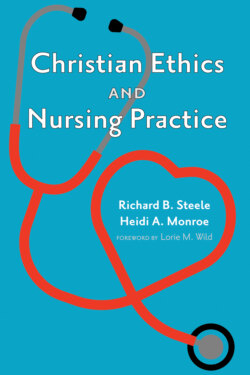Читать книгу Christian Ethics and Nursing Practice - Richard B. Steele - Страница 8
Foreword
ОглавлениеNursing has been defined in a variety of ways over the centuries. Few would dispute that nursing is a relational profession. Nurses, as they tend to the well-being of others, often at the most critical times of life and death, confront difficult choices. As such, nursing is an ethical business. In fact, year after year, the trustworthiness of nursing continues to outrank other professions in public polls.
Building trust among the public does not happen by accident. Nursing education, built on a foundation of the liberal arts and sciences, involves teaching the art, science, and skills of nursing. Yet beyond the fundamentals, nursing education plays a central role in character formation as well as cultivating professional and ethical comportment.
Within this context, Richard B. Steele and Heidi A. Monroe offer a new framework to understand ethics in nursing and, more broadly, in healthcare. These authors bring a pairing of theological (Steele) and nursing and bioethics (Monroe) experience and expertise to this work.
The authors developed and use the framework detailed in this text as part of a required graduate nursing course designed to “explore the discipline through a theologically informed set of values.” The university policy provides direction, explaining that
in some cases this engagement will result in an alignment with key movements of a particular discipline. In other cases it may lead to a critique of some of the discipline’s foundational assumptions. But in all cases the engagement will reflect both a deep knowledge and proficiency in the discipline itself and a rigorous and sensitive application of relevant theological principles and values.
Steele and Monroe have taken this mandate to a higher level by working together in the classroom and in crafting this text. The theological grounding and their interdisciplinary partnership are what distinguishes their course and this text from being simply another course in nursing and bioethics. Their deep commitment, not only to the course but most importantly to students, provides a rich perspective for teaching, learning and professional development.
Initially, when planning the course, the simple goal was to have graduate nursing students think about their clinical practice differently by understanding and applying a new paradigm for professional nursing values and ethics. What Steele and Monroe have accomplished is to provide a framework that helps Christians appreciate a new way to integrate elements of biblical guidance with practice. At the same time, those professing other faiths, or those who do not claim any faith tradition, gain an understanding of the biblically grounded “strands” of moral discourse that shape our laws and ethical practice. They artfully align the four strands—law, holiness, wisdom and prophecy—with the American Nurses Association’s Code of Ethics for Nurses with Interpretive Statements. Rather than compete with other ethical theories and decision-making models, their unique approach to the Code complements rather than supplants these classic frameworks, providing a fresh perspective.
The authors bring experience, expertise and a deep commitment to their disciplines to the course and, most important, to their students’ learning and professional development. Each is a gifted teacher. Yet, one of the most exciting and novel features of their text is the way in which, along with the course as a whole, it reflects the shared endeavor of teaching and learning. In the classroom and through online discussion boards, Steele and Monroe engage students by inviting them to share exemplars from their own practice that illustrate the themes embedded in the Code along with the norms of Christian discipleship mapped out in the Bible. In short, they recognize that each person in the classroom—whether student or teacher—contributes to the experience of learning. In doing so, the principles and practices come alive.
The clinical exemplars shared throughout the text will resonate with the nurses or other practitioners who read this book. Too often, texts regarding ethical conflicts feature profound ethical dilemmas such as euthanasia, assisted suicide, abortion or organ transplant, to name a few. Most clinicians will encounter few, if any, large-scale ethical dilemmas. In contrast, the exemplars included here reflect the countless real-life, day-to-day situations that nurses and other clinicians confront in their practice that demand ethical comportment and decision-making. Nurses from all specialties will recognize the scenarios shared precisely because the authors of the exemplars are practicing, bedside nurses.
Another feature of this work that sets it apart from other ethics texts is the inclusion of classic works of art to convey the central themes. The selected images add another layer of depth to a very rich narrative. Taken together, the art, along with the biblical and professional narratives, illustrate the human experience that grounds and frames nursing practice.
Any ethics text runs the risk of becoming a discussion of ethical dos and don’ts. Here, Steele and Monroe elegantly weave a narrative that builds a foundation for understanding the ANA Code as well as providing guidance for action in alignment with the same. One perspective shared as a part of a student’s course feedback offers a succinct summary not only of the course from which Christian Ethics and Nursing Practice was born but also of the gifted teaching and writing of Steele and Monroe:
While this course served as a religious requirement, the course as a whole beautifully integrated faith with the nursing profession in a seamless manner. The readings and in-class discussions emphasized the overlap and sparked rich dialogue between a diverse religious cohort.
To create a tapestry of such varied backgrounds, perspectives, and goals for learning and nursing practice demands gifted teachers, wise scholars and committed professionals. As readers, we are fortunate beneficiaries of what I hope will become a valued resource for nursing ethics for faculty, students and practicing nurses alike.
—Lorie M. Wild, PhD, RN, NEA-BC
Dean, School of Health Sciences
Seattle Pacific University
